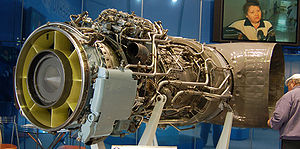| This article needs additional citations for verification. Please help improve this article by adding citations to reliable sources. Unsourced material may be challenged and removed. Find sources: "Lotarev D-136" – news · newspapers · books · scholar · JSTOR (June 2021) (Learn how and when to remove this message) |
| D-136 | |
|---|---|

| |
| The Ivchenko-Progress D-136 engine on display at the 2009 MAKS Air Show. | |
| Type | Turboshaft |
| National origin | Soviet Union |
| Manufacturer | Ivchenko-Progress / Motor Sich |
| Major applications | Mil Mi-26 |
| Developed from | Lotarev D-36 |
| Developed into | Progress D-236 |
The Lotarev D-136 is a turboshaft engine from the ZMKB Progress Design Bureau. The engine powers the Mil Mi-26 "Halo" helicopter. Development of the engine had begun in about 1972.. The D-136 first flew on a production Mi-26 helicopter in 1980.
Design
The core of the engine is identical to the Lotarev D-36 turbofan from which the D-136 is derived.
Applications
Specifications
Data from Mil's heavylift helicopters, pages 90-91
General characteristics
- Type: 3-spool turboshaft
- Length: 3,964 mm (13 ft 0 in)
- Width: 1,670 mm (5 ft 6 in)
- Height: 1,160 mm (3 ft 10 in)
- Diameter:
- Dry weight: 1,050 kg (2,315 lb)
Components
- Compressor: 7-stage subsonic high-pressure (HP) compressor, 6-stage transonic low-pressure (LP) compressor
- Combustors: Annular combustion chamber, 24 fuel nozzles, 2 igniters
- Turbine: 1-stage HP turbine @ 14,170 rpm, 1-stage LP turbine @ 10,950 rpm, 2-stage free-power turbine @ 8,300 rpm (±300 rpm)
Performance
- Maximum power output: Takeoff: 10,000 equivalent shp (7,500 kW); Contingency: 11,400 equivalent shp (8,500 kW); Sustained: 8,500 equivalent shp (6,338 kW)
- Overall pressure ratio: 18.3
- Air mass flow: 36 kg/s (79 lb/s)
- Turbine inlet temperature: Takeoff: 1,478 K (2,660 °R; 1,205 °C; 2,201 °F); Maximum: 1,516 K (2,729 °R; 1,243 °C; 2,269 °F)
- Specific fuel consumption: Takeoff: 0.198 kg/(hp⋅h) (0.265 kg/kWh; 0.436 lb/(hp⋅h)); Cruise: 0.206 kg/(hp⋅h) (0.276 kg/kWh; 0.454 lb/(hp⋅h))
- Power-to-weight ratio: 4.93 shp/lb (8.1 kW/kg)
See also
Related development
Comparable engines
Related lists
References
- ^ Gordon, Yefim; Komissarov, Dmitriy; Komissarov, Sergey (2005). Mil's heavylift helicopters: Mi-6/Mi-10/V-12/Mi-26. Red Star. Vol. 22. Midland Publishing. ISBN 1-85780-206-3. OCLC 62343294.
- Bessette, John; Carolla, Mark (December 1981). Bree, Betsy (ed.). "The Mi-26/Halo". Review of the Soviet ground forces. No. RSGF 4-81. Defense Intelligence Agency. p. 10.
Bibliography
- "Ukraine starts testing improved engine for heavy helicopters". Russian Aviation Insider. 26 January 2017.
- "Soviets develop turboshaft powerplant for transports". Paris Air Show. Aviation Week & Space Technology. 15 June 1981. pp. 28–29. ISSN 0005-2175.
External links
- "D-136 turboshaft". SE Ivchenko-Progress. Retrieved 11 June 2021.
- "AI-136T /D-136T-2 / AI-136T-2 turboshaft engine family". SE Ivchenko-Progress. Retrieved 11 June 2021.
- "D-136 / D-136 series 1". Motor Sich. Retrieved 11 June 2021.
- "D-136-2". Motor Sich. Retrieved 11 June 2021.
| Ivchenko-Progress aircraft engines | |
|---|---|
| Piston engines | |
| Turboshafts/turboprops and auxiliary power units (APU) | |
| Turbofans and propfans | |